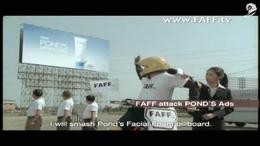Innovation > Innovation
THE FACE OF LITTER
OGILVY & MATHER GROUP HONG KONG, Hong Kong / HONG KONG CLEANUP / 2015
Awards:
Overview
Credits
Overview
ClientBriefOrObjective
Every day, a staggering 16,000 tons of waste is dumped in Hong Kong. This figure consists of over 1.3million plastic bottles and over a ton of plastic bags,. Despite heavy penalties, littering remains a citywide problem.
It remains the responsibility of each of the 7million Hong Kong residents to do something. Not everyone has the time to go around collecting litter, but each resident can contribute in the same way., by not littering.
One of the biggest problems in this incredibly law abiding society, is that litter is a faceless crime – if you don’t catch someone red-handed, they go away unpunished.
On 22nd April 2015, Earth Day, we wanted to create social change, around the problem of litter and to raise awareness of the extent of littering across the city, pinpointing that each and every one of us is responsible to some extent. Through this, we aimed to remind people that littering is a real crime.
Genetic researchers have recently developed a methodology of DNA-Phenotyping that can identify criminal suspects based on small samples of hair, saliva or human excretion. This allows them to build a profile – including hair and skin colour, ethnicity, gender and more – going one step further than ever before…actually creating a recognizable “face”, which police can use to identify suspects.
By using a technology, which has traditionally has been reserved for high profile crimes, and instead using it as part of public service announcement, we placed real importance and focus on the crime of littering. Allowing us to be the first city to literally put a face to this anonymous crime.
Implementation
In advance of Earth day 2015, litter samples were collected from high traffic, high litter areas of Hong Kong. These samples were sent to Parabon Nanolabs, where DNA was extracted and analyzed. Parabon Nanolabs makes use of the newly developed SnapShot™ analysis system, developed in order to generate investigative leads by predicting physical appearance of an individual from a DNA sample.
To understand SnapShot™, it’s essential to understand DNA-Phenotyping - the prediction of physical appearance from DNA. DNA carries genetic instruction sets for an individual’s physical characteristics, producing the wide range of appearances among people. By determining how generic information translates into physical appearance, it is possible to “reverse-engineer” DNA into a physical profile. SnapShot™ reads tens of thousands of genetic variants or genotypes from a DNA sample and uses this information to predict what an unknown person looks like. Funded by the US Department of Defense, SnapShot™ Forenstic DNA-Phenotyping System accurately predicts genetic ancestry, eye, hair and, skin colour, freckling and face shape in individuals from any ethnic background. This allows Parabon to build a profile which goes one step further than ever before – creating a recognizable “face” of the criminal, which authorities can use to identify suspects.
SnapShot™ takes advantage of modern Single Nucleotide Polymorphism (SNP) technology, translating select biomarkers from a DNA sample into predictions about various physical traits of its source.
The steps taken in the SnapShot™ technique can be described as follows:
1. Sample collection – evidence collected, any human sample which contains DNA
2. Genotyping – the Genotyping lab produces an SNP profile or DNA blueprint, this data is given to the SnapShot™ team for analysis
3. Composite – using SnapShot™ technology Parabon Nanolabs predicts physical traits and produces a SnapShot™ report which includes hair colour, eye colour, skin colour, freckling, face shape, and ancestry.
Outcome
On 22.4.2015, Earth Day we strived to create social change, around the problem of litter in Hong Kong, supporting local initiative Hong Kong CleanUp. Raising awareness of the extent of littering across the city, pinpointing that the 7million residents are responsible to some extent, giving people a reason to stop littering, beyond mere social consciousness.
The biggest problems is that litter is a faceless crime.
But, by using technology, traditionally reserved for high profile crimes, and instead using it for a public service announcement, we placed importance and focus on the crime of littering. Allowing us to be the first city to literally put a face to this anonymous crime.
With the objective of creating social change, creating awareness and ultimately changing behavior, we can appreciate how the message “Don’t Litter” has created a social consciousness. During the 14-day period, over 3.9million people engaged on Social Media across Twitter and Facebook, with the educational video having a total 827,546 views. The response from the public has been immense with the campaign spreading outside of Hong Kong and into South East Asia and even as far as the US and Brazil with an earned media value of HK$5million.
More Entries from Creative Innovation (including Business Solutions in Association with a Brand or Creative Campaign) in Innovation
24 items
More Entries from OGILVY & MATHER GROUP HONG KONG
24 items








